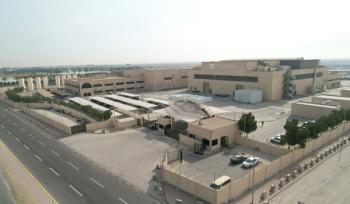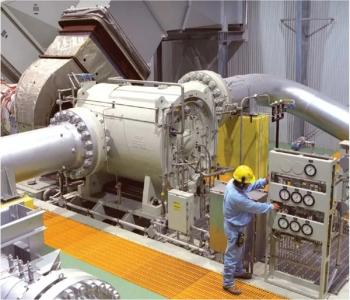
TURBO SYMPOSIUM 2014
DRIVER SELECTION, SUBSEA PUMPS, COMPRESSOR DESIGN, MAGNETIC BEARINGS AND OFFSHORE TURBOMACHINERY FEATURE HEAVILY AT THIS ANNUAL EVENT
The 43rd Turbomachinery and 30th Pump Users Symposia took place in Houston in September under the auspices of Texas A&M University’s Turbomachinery Laboratory. Dr. Dara Childs, Director of the Turbomachinery Lab commenced proceedings, announcing a highest ever attendance of more than 6,150 attendees from over 50 countries (Figure 1).
Those in attendance represented the petrochemical, oil refining, oil & gas production, utility, power, aerospace and other related industries. And they were treated to a program of lectures, tutorials and case studies spanning every aspect of turbomachinery and pump design, operation and maintenance.
Paul Cooper, Founding Member of the Pump Advisory Committee, delivered the keynote (Figure 2). His theme, advancing pump and turbomachinery innovation by building on the past, enabled him to lecture on the rich history of the Turbomachinery and Pump Symposia as a venue to showcase the latest and greatest in the industry. He noted that the many groundbreaking papers delivered over the years are still available in an extensive database.
“The archives of the symposium can help us in achieving goals such as better water injection under extreme pressure for deep sea wells,” said Cooper. “As the wellhead pressure is much greater than the hydrostatic water pressure at the sea bottom, injection pumps need to be able to generate about 15,000 psi, which is at least twice the current maximum.”
Areas requiring developmental attention to reach such high pressures, according to Cooper, include minimizing pressure pulsations and stresses, vibration, resonance, cavitation damage and fluid dynamic thrust loading. To avoid cavitation damage, he suggested that the industry needs impellers than can operate at higher inlet tip speeds without cavitation.
Offshore fields
Offshore deployment of turbomachinery in the oil & gas sector is experiencing a major boom. Floating Production Storage and Offloading Vessels (FPSOs), for example, are a popular choice for large offshore oil and gas fields. Major clusters of these ships are found in Brazil, the North Sea, West Africa and in the Asia Pacific region.
“FPSOs are giant ships with gas processing plants on them, which are found near the largest offshore oil and gas fields,” said Harry Miller, Dresser Rand’s Director of Emerging Technologies. “As there can be up to an 18% roll angle aboard, this motion has to be considered in the engineering.”
That is why the drivers and onboard compressors have to be packaged carefully with special base plates that compensate for pitch and roll while minimizing torque, bending and vibration. Dresser-Rand supplies three base package designs: a torque box, a torque tube or wide flange beams to support the compressor package. While FPSOs are a proven technology, subsea compression is still earning its stripes (Turbomachinery International Sept/October 2014). Yet the topic was front and center at the Turbo Symposium and one of the most talked about subjects on the exhibit floor.
Thom Eldridge, Senior Rotating Equipment Engineer and Principal Technical Expert for Novel Technology at Shell, gave an overview of subsea processing, which encompasses pumping, electrical, separation, reinjection and compression. While early work in subsea boosting used turbine drivers, the current trend is towards electric-motor driven equipment. Particularly when it comes to subsea compression, water depths and the hermetically sealed nature of the packages require an electric motor. “Having a driving element at the wellhead is beneficial in order to overcome pressure drop and produce a higher extraction rate,” said Eldridge.
Shell has been extensively involved in multiphase pumping. When it comes to dry gas compression, Eldridge liked the concept of having many subsea wells tying into a single compressor on the seabed with a tieback to an onshore refinery or FPSO.
For Ormen Lange in the North Sea, Shell has been engaged in a massive qualification- and-testing program that included the piloting of a vertically oriented, electric motor-driven compressor using active magnetic bearings (AMB). “We need to prove the viability of this technology on the sea floor,” said Eldridge.
The focus at Ormen Lange has been on dry gas, but work is also ongoing elsewhere on wet gas compression. The benefit is that it simplifies subsea operations by eliminating the need for separation. One approach is a centrifugal compressor with a wet-gas-tolerant first stage. Another approach is the counter-rotating design from OneSubsea. In the next couple of years, the industry should see application of a wet gas compressor on the sea floor with Statoil’s Gullfaks project.
Aker Solutions, a subsea pump and compression system supplier from Norway, has delivered the Ormen Lange Pilot subsea compression system as well as the subsea compression system for the North Sea’s Asgard Field. While the former makes use of a 12.5 MW GE Blue-C compressor, the latter involves two 11.5 MW Hofim compressors from MAN Diesel & Turbo.
Stein Jorgensen, Chief Engineer at Aker Solutions, reported that the Ormen Lange compressor has now been run for more than 3,000 hours at Shell’s test facility on the west coast of Norway. “We have had to overcome issues such as limited axial thrust at some operating points,” said Jorgensen. “We’ve improved tuning capabilities for our AMB settings and reduced sub-synch vibration levels, as well as making improvements in motor cabling design, and we are currently addressing the control of any carried-over liquid in the compressor sump.”
Urs Baumann, Head of R&D for Compressors at MAN Diesel and Turbo (Figure 3), pointed out that the last ten years were dedicated to the development of high speed motors and magnetic bearings that are more tolerant to liquids. MAN’s 18 MW Hofim compressor which is to be used by Statoil at Asgard completed qualification testing in 2012.
“Although this is not a wet gas compressor, the Hofim machine is capable of running well with a liquid content in the gas of up to 4% by volume,” said Baumann. “We are also working to create our own liquidproof AMBs.”
With subsea operation planned for May of 2015, the entire subsea processing plant will weigh 4,800 tons and cover half the size of a football field. The large template has already been installed at a depth of 260 meters and is waiting to receive the compression modules in early 2015. To accelerate commissioning and to increase reliability, all modules are subjected to a submerged system integration test onshore.
Extensive testing, as part of the Ormen Lange pilot project, demonstrated that the GE Blue-C compressor has a tolerance for surge events. But Manuele Bigi, Subsea Compression Technical Lead, for GE Oil & Gas, said the company is dealing with problems, such as liquid in the machine. “More detailed seal testing is ongoing to find the cause and devise better sealing techniques,” he said.
Magnetic bearings
With AMBs being so much in the forefront of subsea development, it is fitting that the Eight Edition of API 617, which includes new requirements for AMBs, has recently been released. A tutorial at the Turbo Symposium laid out the changes to that standard.
Erik Swanson, President and Chief Engineer of Xdot Engineering and Analysis, explained that the revision had come about due to the magnetic bearings becoming much more common, particularly in oil and gas. “AMBs are becoming the standard in subsea and in other oil & gas applications.”
The revisions to API 617 for magnetic bearings were developed primarily within the 2009 and 2010 time period. Since then, the standard has been under peer review and verification. Even So, Swanson expects some fine tuning to be required in the next revision of API 617.
Annex E of API 617 is completely new and contains requirements related to bearing load capacity requirements, rotordynamics, auxiliary bearings, and requirements for independent audits. New magnetic bearing compressors will have to meet these requirements.
“Performing some of the rotordynamic analyses called for in API 617 for AMB’s will require capabilities that are not implemented in some commercially available rotordynamic software packages,” said Swanson. “For instance, some packages do not fully implement a complete coupled mathematical model for an AMB supported rotor, or all of the new transfer function analyses.”
Additionally, Swanson noted that due to the soft nature of AMBs, transmitted dynamic forces are usually smaller (for a given vibration amplitude). As this reduces the likelihood of fatigue damage to other machine components, a change has been made to the specifications related to unbalance requirements.
Swanson was followed by Larry Hawkins, Cofounder and Director of Magnetic Bearing Technology at Calnetix Technologies, who covered the technical details of API 617 and the mathematical details that impact AMBs. “AMBs apply counteracting attractive magnetic forces using electromagnetic actuators,” said Hawkins. “These forces are controlled by adjusting control coil currents to adjust the position of the shaft.”
A typical AMB system consists of two radial and one axial bearing. The electromagnets are often arranged in four quadrants set at 45º angles to the vertical. As AMBs have a force limit, touchdown bearings are also needed to support the rotor in certain conditions. The addition of these touchdown bearings helps in preventing failures.
Driver selection
A panel on driver selection solicited a long Q & A period with users anxious to understand the pros and cons of various drivers in different situations. Mark Weatherwax, Consulting Machinery Engineer at Chevron Energy, explained that there were many considerations to take into account including the type of facility, environmental constrains and economics.
For example, the facility could be processing ammonia, ethylene or LNG, and it could be engaged in offshore processing or refining. The production of the plant, therefore, tends to be a primary factor in driver selection. That means you have to look at the impact on utilities, your source of feed stock, your process requirements, and your location which determines climate and may influence fuel availability.”
A strong local grid compared to a weak grid at a remote site can impact which driver is picked. Some places have abundant inexpensive electric power, natural gas, other fuels or even steam. Harnessing those resources can help to reduce costs, and that can largely determine which type of equipment has to be purchased.
At the same time, emissions and other environmental limitations are becoming more critical in choosing the right driver. The decision can vary markedly depending on whether low NOx is being demanded, Selective Catalytic Reduction (SCR) is to be included, and waste heat recovery units are involved. But costs have to be defined early in the process otherwise you might make wrong choices.
As part of the cost equation in driver selection, users should carefully consider maintenance and parts replacement. One plant, for example, compared Capex for two proposed drivers but had not figured out how much it would cost to maintain them over their lifecycle.
If the facility is handling sour gas, the amount of time required for maintenance can make or break project success. High H2S content could mean maintenance personnel have to be kitted out in full hazard suits just to perform the smallest task. In that situation, more weight should be given to a driver that requires the smallest amount of maintenance. The same applies in extreme climates.
Food for thought
Further aspects to ponder: if modular replacement is being done, add in the cost of spare modules; commonality of drivers across multiple sites might reduce costs by enabling sharing of parts and maintenance knowledge; process requirements might trump all other criteria as the plant’s production profile demands specific equipment to minimize downtime or guarantee availability; do not forget about power derates due to ambient conditions that are more of an issue with some drivers; and the speed and power range of certain compressors can cut down the number of driver options.
A centrifugal compressor running at 12,000 RPM, for example, might only have a few potential driver candidates that could match that speed. There is also the added cost and risk associated with new technology. It should only be selected when the latest equipment will slash costs dramatically. But do not forget that you will have added costs due to heavier qualification and testing requirements.
Following Weatherwax of Chevron, Rainer Kurz, Manager of Systems Analysis at Solar Turbines, emphasized the performance characteristics of different types of gas turbine drivers such as single- or multishaft, and aeroderivative or industrial. “Some people only look at ISO performance, but that is meaningless if the plant is at a different elevation or has a different temperature profile,” said Kurz. “Many compressor stations are vastly oversized. Take that into account in your calculations otherwise you end up with a much bigger driver than you will ever use.”
When it comes to choosing between a GT and an electric motor, he recommended that users make the comparison at the system level rather than only the driver itself. For an electric motor drive, you have to know where the power will come from, whereas a GT generates the power needed to run the compressor.
“An electric motor drive can be problematic if power is not easily available,” said Kurz. “Also, you can’t claim emissions benefits for an electric motor driver if the electricity comes from a grid based on coal.”
Looking at driver selection from an Engineering, Procurement and Construction (EPC) perspective, Vinod Patel, Chief Technical Advisor for Machinery Technology at KBR (Houston), felt it was crucial for the EPC provider to take an active position at the design conception stage to understand the drivers required. He voiced the opinion during the panel discussion that it was not wise to rush into the selection of new drivers without either conducting proper technology qualification or having proven experience in similar services.
“Plant life could be 30 to 40 years so you need to live with your decision for the life of the plant,” said Patel.
The three main types of driver, he said, were electric, steam and GT. Get to know the limitations and experience of each driver, as well as the experience of that driver in a specific use case. He made a final point on energy sources. Perhaps an ivory tower view of driver selection might reveal a gas turbine to be the best choice. But if gas is not readily or inexpensively available, it may be a big mistake.
“Energy source is a key parameter,” said Patel. “We have to make sure we pick a driver that does not rely upon an unreliable source.”
This year’s Turbomachinery and Pump Users Symposia achieved a highest ever attendance of over 6,125 (up over 300 from 2013). At the same time, the number of exhibitors is also thriving — 343 in Houston in September (Figure 4). So it is no surprise that the event is expanding its scope. As well as the Middle East Turbomachinery Symposium (METS), which was initiated in 2011, the organizers are adding the Asia Turbomachinery and Pump Symposium (ATPS) in 2016.
METS will take place in Doha, Qatar, February 15-18, 2015. Dr. Childs said attendance should be well up due to the expectation of walk-in traffic from local oil & gas companies such as Qatar Gas and RasGas. “While the average show has a user population that comprises 30% of total attendance, it is more like 70% at METS,” said Childs.
Symposia expansion
ATPS is scheduled to take place in Singapore, February 22-25, 2016. The advisory committee consists of members from companies, such as Flowserve, Singapore Refining Co., Kop-Flex (Emerson), Dresser- Rand, MHI Compressor Corp., Shell, GE Oil & Gas, Conoco Phillips, Chevron and Qatar Petroleum. “We expect to see attendees coming from places like Japan, Korea, China, Malaysia, India and Singapore,” said Dr. Luis San Andres, who leads the Tribology Group at the Texas A&M University Rotordynamics Lab. “The call for papers at this show has begun.”
Childs views the expansion of the Turbo Symposium as an important aspect of furthering global turbomachinery education. “This format works and can’t be replaced as there is only so much you can do digitally and on the web,” said Childs (Figure 5). “Attending a symposium and meeting your peers is a learning experience that can’t be matched online looking at past proceedings.”
Newsletter
Power your knowledge with the latest in turbine technology, engineering advances, and energy solutions—subscribe to Turbomachinery International today.




